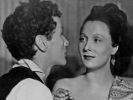Eye For Film >> Movies >> Les Enfants du Paradis (1945) Film Review
After a major 4K digital restoration, the premiere of which came during the 2011 Cannes Film Festival, Marcel Carné's Les Enfants Du Paradis is now released on high-definition Blu-ray and DVD, replete with over two hours of extra features. I admit to never having seen the movie before, and therefore to knowing nothing of why it was voted 'the best French film ever made' by the French Film Academy in 1995. Post viewing I can fully understand its lofty position, not just in the annals of French cinema but as a classic of world cinema. Breathtakingly ambitious, exquisitely realised and performed and made under extreme circumstances – it was filmed during 1943/44 with France under Nazi occupation – Les Enfants Du Paradis is an absolute joy to behold and a monument to the power of the arts to transcend oppressive social and political climates.
An epic melodrama centering on the fight between four distinctly different men for the love of artiste Garance (Arletty), Carné's movie, written by Surrealist, poet and screenwriter Jacques Prévert, plays out in and around the Funambules theatre on Paris' 'Boulevard du Crime' in the years leading up to the 1830 revolution. Class, freedom, crime, morality, reputation and performance are woven into a tale spanning several years and presented in two parts; Boulevard of Crime and The Man in White.

Sensitive mime artist Baptiste (Jean-Louis Barrault), womanizing actor Frédérick Lemaître (Pierre Brasseur), dandy criminal Lacenaire (Marcel Herrand) and Count Douard de Montray (Louis Salou) all fall under the spell of Garance, leading to heartbreak, tragedy, thwarted passions and eventually murder amidst the bawdy, hothouse atmosphere of the theatre world. Arletty's luminous yet Earthy presence provides Garance with the necessary, and, crucially, believable attributes to bewitch all four of her potential suitors – fragile, exuberant, sinister and privileged respectively.
As the theatrical pieces presented within the movie are symbolic of the social, physical and emotional environments of the characters performing them, so the film itself is for those acting and filming them. All the world really is a stage in Les Enfants Du Paradis, from its fictional representation of places and characters drawn from historical real life to the, then, here and now reality of a cast and crew that included Jews, black marketeers, collaborators, homosexuals, resistance members and a lead actress embroiled in a passionate affair with a German officer.
The movie is symbiotically tied into the surrounding climate at the time, fantasy doggedly continued in the face of harsh reality in order to endure that reality. It feels like Carné and Prévert knew that a movie of such sweeping beauty, regardless of the tragedy at the heart of the narrative, needed to be made given the world around them had descended into barbarous oppression.
One of numerous Carné and Prévert collaborations, Les Enfants Du Paradis is a period piece on a scale to rival anything seen before or since, with the Paris of the early 19th century brought to glorious life in the Studios de la Victorine in Nice, Pathe's studios in Joinville-le-Pont in Paris, and on the streets of both cities. It's a movie that you can almost touch and taste as well as see and hear, such is the detail and vitality running through every lovingly restored frame.
Teeming with hundreds of extras, filled with well rounded, unforgettable secondary characters, accompanied by a lush orchestral score, brimming with the rich, evocative dialogue you would expect from someone of Prévert's standing and filmed with such lightness of touch and fluidity that it retains its freshness to this day, Les Enfants Du Paradis is a jaw-dropping achievement; every facet of the narrative, visual imagery, set design, musical score, production values, writing and direction is of the very highest order.
Reviewed on: 17 Sep 2012
















